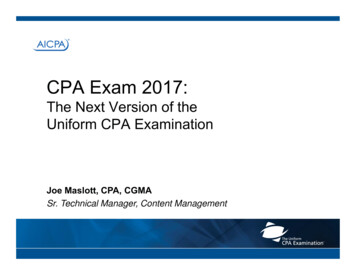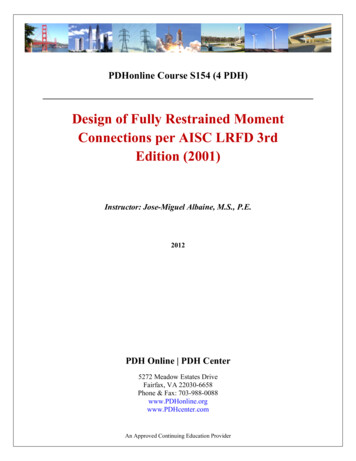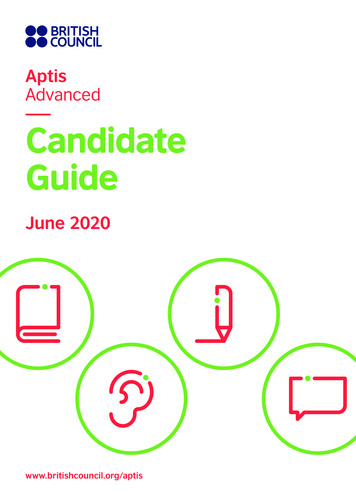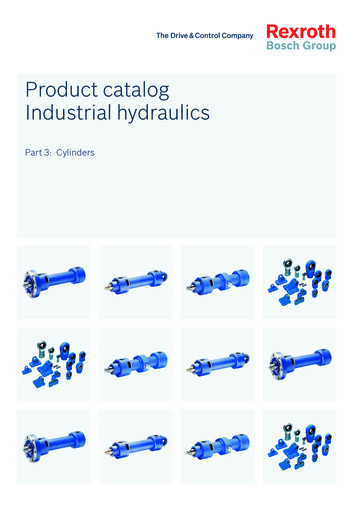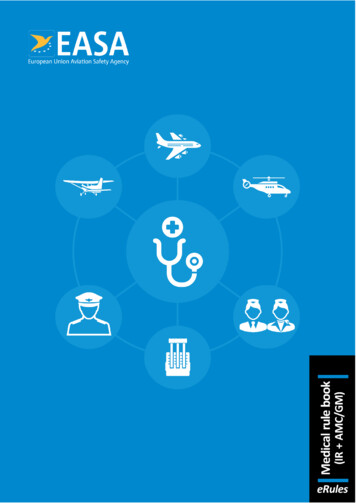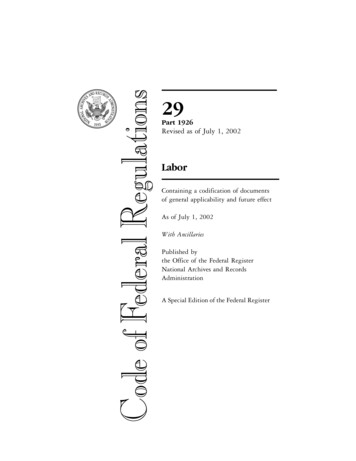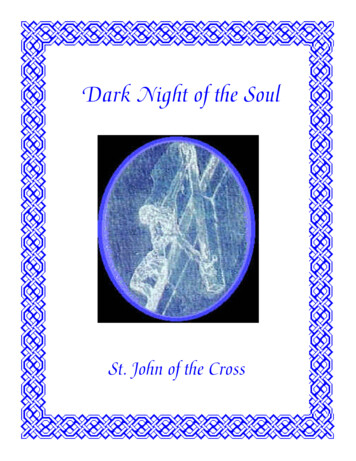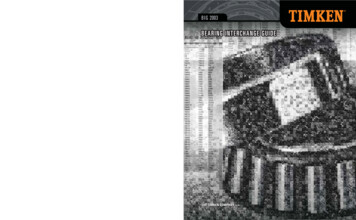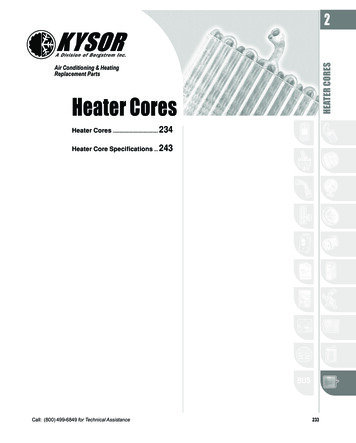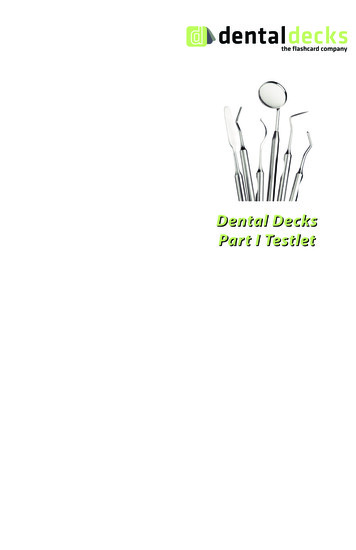
Transcription
NoticeMedicine is an ever-changing science. As new researchand clinical experience broaden our knowledge,changes in treatment and drug therapy are required.The authors and the publisher of this work have checkedwith sources believed to be reliable in their efforts toprovide information that is complete and generally inaccord with the standards accepted at the time of publication. However, in view of the possibility of humanerror or changes in medical sciences, neither the authorsnor the publisher nor any other party who has been involved in the preparation or publication of this workwarrants that the information contained herein is inevery respect accurate or complete, and they disclaimall responsibility for any errors or omissions or for the results obtained from use of the information contained inthis work. Readers are encouraged to confirm the information contained herein with other sources. For example and in particular, readers are advised to check theproduct information sheet included in the package ofeach drug they plan to administer to be certain that theinformation contained in this work is accurate and thatchanges have not been made in the recommendeddose or in the contraindications for administration. Thisrecommendation is of particular importance in connection with new or infrequently used drugs.Copyright ã 2013-2014 Dental Decks, Inc.All rights reserved. No part of this publication may be reproduced or transmitted in anyform or by any means, electronic or mechanical, including photocopying, recording, orany information storage and retrieval system, without permission in writing from the author and publisher.Dental DecksPart I TestletPart INoticeMedicine is an ever-changing science. As new researchVisit us at www.dentaldecks.comand clinical experience broaden our knowledge,changes in treatment and drug therapy are required.The authors and the publisher of this work have checkedwith sources believed to be reliable in their efforts toprovide information that is complete and generally inaccord with the standards accepted at the time of publication. However, in view of the possibility of humanerror or changes in medical sciences, neither the authorsnor the publisher nor any other party who has been involved in the preparation or publication of this workwarrants that the information contained herein is inevery respect accurate or complete, and they disclaimall responsibility for any errors or omissions or for the results obtained from use of the information contained inthis work. Readers are encouraged to confirm the information contained herein with other sources. For example and in particular, readers are advised to check theproduct information sheet included in the package ofeach drug they plan to administer to be certain that theinformation contained in this work is accurate and thatchanges have not been made in the recommendeddose or in the contraindications for administration. Thisrecommendation is of particular importance in connection with new or infrequently used drugs.Telephone: 1-800-457-7126Copyright ã 2013-2014 Dental Decks, Inc.All rights reserved. No part of this publication may be reproduced or transmitted in anyform or by any means, electronic or mechanical, including photocopying, recording, orany information storage and retrieval system, without permission in writing from the author and publisher.Dental DecksPart I Testlet
Occlusion arM—Buccal cusp of the md. 1st premolar occludes with the Mesial marginal ridge of the mx. 1st premolarO—Buccal cusp of the md. 2nd premolar occludes with the Occlusal embrasure of the mx. 1st and 2nd premolarsO—Mesiobuccal cusp of the md. 1st molar occludes with the Occlusal embrasure of the mx. 2nd premolar and mx. 1st molarC—Distobuccal cusp of the md. 1st molar occludes with the Central fossa of the mx. 1st molarO—Mesiobuccal cusp of the md. 2nd molar occludes with the Occlusal embrasure of the mx. 1st and 2nd molarsC—Distobuccal cusp of the md. 2nd molar occludes with the Central fossa of the mx. 2nd molarD—Lingual cusp of the mx. 1st premolar occludes with the Distal marginal ridge of the md. 1st premolarD—Lingual cusp of the mx. 2nd premolar occludes with the Distal marginal ridge of the md. 2nd premolarC—Mesiolingual cusp of the mx. 1st molar occludes with the Central fossa of the md. 1st molarO—Distolingual cusp of the mx. 1st molar occludes with the Occlusal embrasure of the md. 1st and 2nd molarsC—Mesiolingual cusp of the mx. 2nd molar occludes with the Central fossa of the md. 2nd molarO—Distolingual cusp of the mx. 2nd molar occludes with the Occlusal embrasure of the md. 2nd and 3rd molars (if present)Occlusion arM—Buccal cusp of the md. 1st premolar occludes with the Mesial marginal ridge of the mx. 1st premolarO—Buccal cusp of the md. 2nd premolar occludes with the Occlusal embrasure of the mx. 1st and 2nd premolarsO—Mesiobuccal cusp of the md. 1st molar occludes with the Occlusal embrasure of the mx. 2nd premolar and mx. 1st molarC—Distobuccal cusp of the md. 1st molar occludes with the Central fossa of the mx. 1st molarO—Mesiobuccal cusp of the md. 2nd molar occludes with the Occlusal embrasure of the mx. 1st and 2nd molarsC—Distobuccal cusp of the md. 2nd molar occludes with the Central fossa of the mx. 2nd molarD—Lingual cusp of the mx. 1st premolar occludes with the Distal marginal ridge of the md. 1st premolarD—Lingual cusp of the mx. 2nd premolar occludes with the Distal marginal ridge of the md. 2nd premolarC—Mesiolingual cusp of the mx. 1st molar occludes with the Central fossa of the md. 1st molarO—Distolingual cusp of the mx. 1st molar occludes with the Occlusal embrasure of the md. 1st and 2nd molarsC—Mesiolingual cusp of the mx. 2nd molar occludes with the Central fossa of the md. 2nd molarO—Distolingual cusp of the mx. 2nd molar occludes with the Occlusal embrasure of the md. 2nd and 3rd molars (if present)
Universal tooth numbering system.Teeth numbering chart for adult teeth.Upper leftUpper rightA few tips on how to prepare for the Clinical Vignetteportion of the NBDE Part I exam:lower leftlower right1. There are 10 Case Scenarios, and each case has 10 questions covering Anatomy, Microbiology, Biochemistry,Physiology, Pathology,and Dental Anatomy. The Vignettes are composed of the following components: A paragraph of patient chief complaint and dental history A chart of patient's medical history and medication usageOrientation of the Universal tooth numbering chart is traditionally "patient'sview", i.e. patient's right corresponds to tooth chart's right side. The designations"left" and "right" on the chart correspond to the patient's left and right, respectively.You will have to click on a button to make the patient medical history chart visible. Sometimes the chart contains valuable informationthat you will need to answer some of the questions, but not all thequestions need that information.Universal tooth numbering system.Teeth numbering chart for deciduous (primary) teeth.Upper leftUpper right2. The questions are clinically oriented rather than straight memorization. The diseases in the case scenarios are MOSTLY commonones patients present with on your dental school’s clinic floor. Becareful with cases such as diabetes, asthma, fractures, bone lesionsetc. Moreover, a lot of dental management, ethics and dentalanatomy questions were blended in.3. Primary and permanent teeth are not given straight out, rather,they are referred to as tooth #17, or tooth K etc. It might be beneficialto write down a teeth number chart along with the occlusion chartduring the tutorial period (see back two pages of this testlet bookletfor examples).Copyright ã 2013-2014 Dental Decks, Inc.Lower leftLower rightUniversal tooth numbering system.Teeth numbering chart for adult teeth.Upper leftUpper rightA few tips on how to prepare for the Clinical Vignetteportion of the NBDE Part I exam:lower leftlower right1. There are 10 Case Scenarios, and each case has 10 questions covering Anatomy, Microbiology, Biochemistry,Physiology, Pathology,and Dental Anatomy. The Vignettes are composed of the following components: A paragraph of patient chief complaint and dental history A chart of patient's medical history and medication usageOrientation of the Universal tooth numbering chart is traditionally "patient'sview", i.e. patient's right corresponds to tooth chart's right side. The designations"left" and "right" on the chart correspond to the patient's left and right, respectively.You will have to click on a button to make the patient medical history chart visible. Sometimes the chart contains valuable informationthat you will need to answer some of the questions, but not all thequestions need that information.Universal tooth numbering system.Teeth numbering chart for deciduous (primary) teeth.Upper leftUpper right2. The questions are clinically oriented rather than straight memorization. The diseases in the case scenarios are MOSTLY commonones patients present with on your dental school’s clinic floor. Becareful with cases such as diabetes, asthma, fractures, bone lesionsetc. Moreover, a lot of dental management, ethics and dentalanatomy questions were blended in.3. Primary and permanent teeth are not given straight out, rather,they are referred to as tooth #17, or tooth K etc. It might be beneficialto write down a teeth number chart along with the occlusion chartduring the tutorial period (see back two pages of this testlet bookletfor examples).Copyright ã 2013-2014 Dental Decks, Inc.Lower leftLower right
CASE SCENARIO 1Age45 YRSScenarioSexFemaleHeight5’6The patient presentswith localized swellingaround tooth #2. There isan abscess, and a largecarious lesion that extends to the pulp.120 lbs.WeightB/P115/65Chief ComplaintLocalized swelling, sharppainHypothyroidismMedical HistoryANSWER KEYSANSWER KEY— CASES 1— 5Question Answer Question Answer QuestionCase 1Case 2Answer QuestionCase 3AnswerCase 4QuestionAnswerCase 51D1C1B1A1A2D2C2B, C, D2C2C3E3B, C, E3C3A3B4B4C4C4E4D5B, E, F5A5D5A5A, EDCurrent MedicationsSynthroid6C6C6B6D6Social HistoryHousewife7C7E7A7C7E8B8D8E8D8B1. Which of the following is the most common cause of this patient’s autoimmune disease?A. Graves’ diseaseB. Thyroid adenomaC. Pituitary adenomaD. Hashimoto’s AnswerANSWER KEY— CASES 6 — 102. Which of the following is the primary etiologic factor of dental caries?A. Lactobacillus sp.B. P. gingivalisC. Actinomyces sp.D. S. mutansE. T. denticolaQuestion Answer Question Answer Question Answer QuestionCase 63. Each of the following are symptoms of hypothyroidism EXCEPT one. Whichone is the EXCEPTION?A. Cold intoleranceB. Weight gainC. Mental slowingD. Dry skinE. RestlessnessCase 71D12C, D, F3D445 YRSScenarioSexFemaleHeight5’6The patient presentswith localized swellingaround tooth #2. There isan abscess, and a largecarious lesion that extends to the pulp.Weight120 lbs.B/P115/65Chief ComplaintLocalized swelling, sharppainMedical HistoryHypothyroidismCase 9Case 101C1A1D2C2C2B, E, 8E8D8A, B, E8B8D9C9C9D9E9B10D10D10B10D10EQuestionAnswerCASE SCENARIO 1AgeCase 8BANSWER KEYSANSWER KEY— CASES 1— 5Question Answer Question Answer QuestionCase 1Case 2Answer QuestionCase 3AnswerCase 4Case 51D1C1B1A1A2D2C2B, C, D2C2C3E3B, C, E3C3A3B4B4C4C4E4D5B, E, F5A5D5A5A, EDCurrent MedicationsSynthroid6C6C6B6D6Social HistoryHousewife7C7E7A7C7E8B8D8E8D8B1. Which of the following is the most common cause of this patient’s autoimmune disease?A. Graves’ diseaseB. Thyroid adenomaC. Pituitary adenomaD. Hashimoto’s AnswerANSWER KEY— CASES 6 — 102. Which of the following is the primary etiologic factor of dental caries?A. Lactobacillus sp.B. P. gingivalisC. Actinomyces sp.D. S. mutansE. T. denticola3. Each of the following are symptoms of hypothyroidism EXCEPT one. Whichone is the EXCEPTION?A. Cold intoleranceB. Weight gainC. Mental slowingD. Dry skinE. RestlessnessQuestion Answer Question Answer Question Answer QuestionCase 6Case 71D12C, D, F3D4Case 8Case 9Case 10B1C1A1D2C2C2B, E, 8E8D8A, B, E8B8D9C9C9D9E9B10D10D10B10D10E
7. Which of the following disorders is characterized by a qualitative platelet defect resulting in impaired platelet adhesion?A.B.C.D.von Willebrand’sHemophilia AHemophilia BHemophilia C8. Which of the following primary teeth is MOST likely to be mobile in this patientdue to the eruption of the succedaneous tooth?A.B.C.D.FGHI9. This patient’s poor habit is often associated with which of the following malocclusions?A. Class IB. Class II, division IC. Class II, division IID. Class III10. During this patient’s orthodontic treatment, new alveolar bone is deposited.Which of the following BEST describes this type of alveolar bone?A. WovenB. CompactC. CementumD. EndochondralE. Intramembranous7. Which of the following disorders is characterized by a qualitative platelet defect resulting in impaired platelet adhesion?A.B.C.D.von Willebrand’sHemophilia AHemophilia BHemophilia C8. Which of the following primary teeth is MOST likely to be mobile in this patientdue to the eruption of the succedaneous tooth?A.B.C.D.FGHI9. This patient’s poor habit is often associated with which of the following malocclusions?A. Class IB. Class II, division IC. Class II, division IID. Class III10. During this patient’s orthodontic treatment, new alveolar bone is deposited.Which of the following BEST describes this type of alveolar bone?A. WovenB. CompactC. CementumD. EndochondralE. Intramembranous4. In primary hypothyroidism, the pituitary does not make enough TSH.Hypothyroidism affects males more than females.A.B.C.D.Both statements are trueBoth statements are falseThe first statement is true, the second is falseThe first statement is false, the second i
M OO CO C D D CO C O 1P 2P 1M 2M 1P 2P 1M 2M M—Buccal cusp of the md. 1st premolar occludes with the Mesial marginal ridge of the mx. 1st premolar O—Buccal cusp of the md. 2nd premolar occludes with the Occlusal embrasure of the mx. 1st and 2nd premolars O—Mesiobuccal cusp of the md. 1st molar occludes with the Occlusal embrasure of the mx. 2nd premolar and mx. 1st molar
